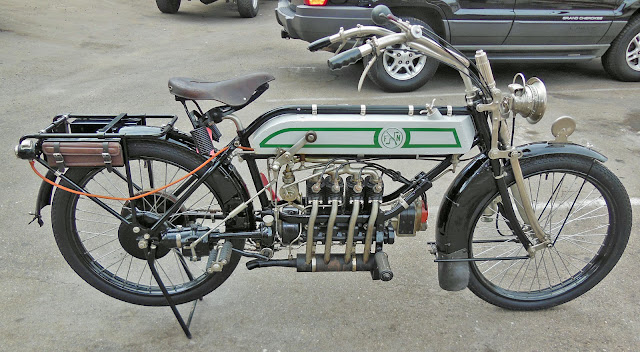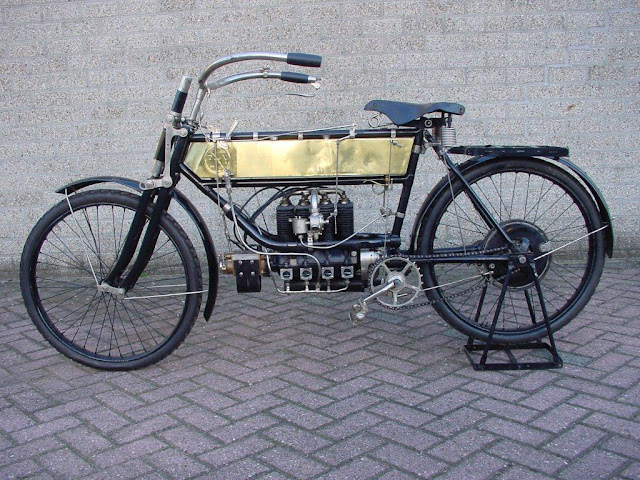FN Four Motorcycle
FN designer Paul Kelecom’s sophisticated four-cylinder engines caused a sensation when introduced early in the last century. Capacity increased from the original 362cc to a limit of 748cc.
This FN Four dates from 1922, and is one of the last 748cc models built before the shaft final drive was changed to a chain. Telescopic forks were used from the earliest model.
The four-cylinder machines built by Belgian firm FN were not the fastest bikes of motorcycling’s early years, but they were certainly among the smoothest and most sophisticated. Introduced in 1904, the FN Four caused a sensation with its advanced specification, which included shaft final drive and a simple but light and efficient chassis. The Four was a commercial success too, remaining in production for more than two decades, and benefiting from several increases in capacity.
FN was originally an armaments manufacturer, having been founded at Herstal, south of Liege, in 1899 under the name Fabrique Nationale d’Armes de Guerre. The firm started producing bicycles in 1901, and in the following year added motorcycles, initially with single-cylinder engines of 225 and 286cc capacity.
The Four was conceived by FN designer Paul Kelecom, who had previously designed and manufactured engines under his own name. These had powered the London-built Ormonde bikes, one of which had taken part in the prestigious Paris-
Madrid race in 1903. From this experience Kelecom knew the problems of early singles, which included slipping drive belts as well as engine vibration and the stress that this passed to the chassis often resulting in unreliability.
Kelecom’s response was to design an in-line four-cylinder motor of 362cc, which ran very smoothly because its inner and outer pairs of cylinders moved in opposite directions, cancelling primary vibration. The four cylinders were separate castings, with non-detachable cylinder heads. In contemporary fashion the FN’s exhaust valves were operated by cams, but its inlet valves were ‘automatic’, opened by piston suction and closed by a light spring.
Shaft final drive
Much less familiar were the FN unit’s long one- piece crankshaft with its five main bearings: and the cast iron crankcase, which featured four small mica windows through which the rider could check that oil was reaching the big-end bearings. Transmission was single-speed until 1908, when a two-speed gearbox and clutch were introduced, but even the earliest Four featured final drive by a shaft that was neatly enclosed in a frame tube.
The frame was a twin-loop design, with tubes running to each side of the engine. There was no rear suspension, but up front the FN featured one of the first telescopic forks, in a system combined with a parallelogram linkage. The front wheel had no brake but the rear had two: a drum that was operated by the rider pedalling backwards, and a hand-operated contracting band acting on the outside of the drum.
Some people considered the FN too strange and complex to succeed, but Kelecom’s creation proved them wrong. Its engine capacity grew to 412cc and then to 491 cc in 1911, increasing top speed to about 40mph (64km/h). The Four was updated and its engine enlarged again to 748cc just before the First World War. during which the occupied factory
Pierce Arrow - First American Four
Percy Pierce, who ran the two-wheeled side of his father's car and bicycle firm in Buffalo, New York, built the first American four in 1909 after returning from Europe with an FN. The Belgian bike's influence was clear, but the Pierce Arrow was no copy. Its larger 696cc engine was a side-valve design, complete with FN- style shaft drive.
And the frame consisted of large-diameter steel tubes which also held fuel and oil. The Arrow was smooth, good for over 50mph (80km/h), and reliable enough to win several endurance events. But the exotic four could not be produced profitably, and Pierce called a halt in 1913.
Produced bikes for the Germany army. After the war its popularity faded and production ended in 1926, three years after a final redesign that included replacing the shaft final drive with a chain.
FN increased the engine s capacity and incorporated improvements which included a clutch and two-speed gearbox during the Four !s lifespan of more than 20 years.
The Belgian marque’s background was in armaments and bicycles. FN produced motorcycles until 1957, when it gave up the struggle to compete for sales with cheap cars.
Specification FN Four (1906)
- Engine Air-cooled inlet-over-exhaust eight-valve in-line four
- Capacity 412cc (48 x 57mm)
- Capacity 4bhp
- Maximum power Single-speed, shaft final drive
- Transmission Steel twin downtube
- Frame Steel twin downtube
- Suspension Telescopic front; rigid rear
- Brakes None front; drum and contracting band rear
- Weight 1651b (75kg)
- Top speed 40mph (64km/h)


















0 comments: